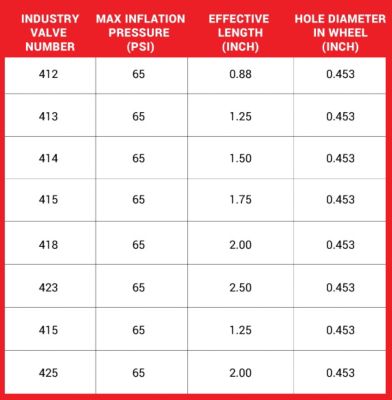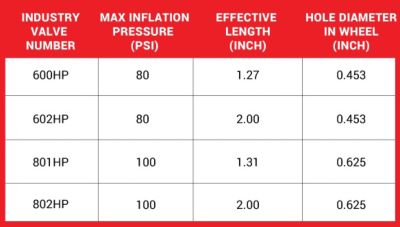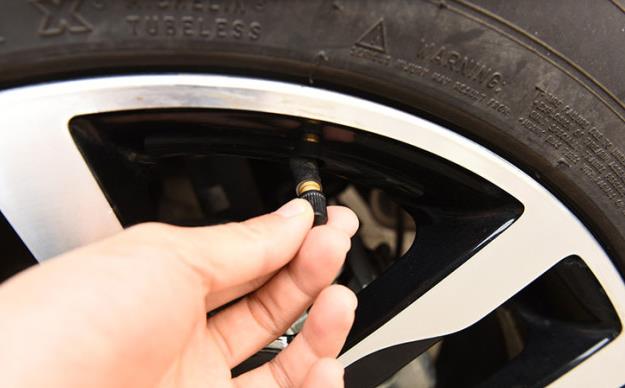Tire Valve Stem: Types, Caps, Cores and Replacements
If you've landed on this page, you likely need a replacement tire valve stem — either that, or you're particularly fascinated with the different types of tire valve stems on the market today.
But do you really know what it is you're looking for? And even if you truly need to change your valve? If your vehicle was manufactured before 2008, then keep on reading. If your vehicle was manufactured in or after 2008, you'll be changing your valves based on your tire pressure monitoring system (TPMS) sensors.
Before you buy, be sure to take a few moments to get to know the tire valve stem varieties, caps, cores and more. Generally speaking, there are three basic types of tire valve stems:
Tubeless rubber snap-in valves
High-pressure tubeless snap-in valves
High-pressure metal clamp-in valves
Read on to see which type is best suited for your particular type of vehicle, wheels, driving conditions and recommended tire inflation pressures.
Check out each chart below, which details the tire valve stem design numbers for each type and dimension, as assigned by The Tire and Rim Association (TRA).
Tubeless Rubber Snap-in Valves
If you drive a regular passenger vehicle, such as a standard-size car or a minivan; a light truck; or a light-duty trailer, then you will likely be interested in a tubeless rubber snap-in valve.
One key factor when considering valve type is maximum inflation pressure — this particular snap-in valve allows a maximum cold tire inflation of 65 pounds per square inch (PSI). You'll be able to find rubber snap-in valves to fit holes that are either 0.453" or 0.625" in diameter and in lengths that range from 0.88" to 2.5".
Finally, most tubeless rubber snap-in valves come with plastic caps, but you can also find some with metal caps — a more aesthetically pleasing option for custom or alloy wheels.
High-Pressure Tubeless Snap-in Valves
If you drive a larger vehicle, such as a medium- or heavy-duty truck or trailer, then you will likely be interested in a high-pressure tubeless snap-in valve.
Again, when considering valve type, you must factor in maximum inflation pressure — this particular snap-in valve should be used when the cold tire inflation pressure exceeds 65 PSI and allows a maximum cold tire inflation of 80 to 100 PSI, depending on the rim hole size. You'll be able to find high-pressure tubeless snap-in valves to fit holes that are either 0.453" or 0.625" in diameter and in lengths that range from 1.27" to 2.0".
What differentiates this type of snap-in valve is that it is made with a thicker base and a metal barrel, but it maintains the same plastic cap as standard tubeless rubber snap-in valves.
High-Pressure Metal Clamp-in Valves
Last, if you drive a track vehicle or a vehicle that may exceed speeds of 130 miles per hour, then you will likely be interested in a high-pressure metal clamp-in valve.
Always take maximum inflation pressure into account when considering valve type — this particular high-pressure metal clamp-in valve allows a maximum operating pressure of 200 PSI, depending on the rim hole size. And, similar to the tubeless snap-in valve, this particular clamp-in valve fits holes that are either 0.453" or 0.625" in diameter, as well as specialty versions, such as those for 0.236" and 0.315" rim holes. Their lengths range from completely flush to 2.0" and come in straight or bent configurations.
High-pressure metal clamp-in valves are made with rubber grommets and attractive metal caps.
Tire Valve Cores
Whether you're using a tubeless rubber snap-in valve, a high-pressure tubeless snap-in valve or a high-pressure metal clamp-in valve, you must ensure that the valve core itself is screwed completely into the valve core chamber.
Valve cores come in a few different varieties — long (standard) and short (high performance); brass (standard); and nickel plated (for tire pressure monitoring systems). If your vehicle has a tire pressure monitoring system, you're going to want a nickel-plated valve core, because brass valve cores within aluminum valve stems can cause corrosion.
Tire Valve Caps
No matter what type of vehicle you drive and what type of tire valve stems you have on your wheels, it's important to always use valve caps. Valve caps keep air from escaping your tire — they are the second, backup seal that prevents tire pressure loss.
The three types of tire valve caps that you'll most commonly encounter are plastic dome (used for everyday driving), metal dome (used for racetrack driving) and metal "screwdriver" (used for removing and inserting valve cores).


























